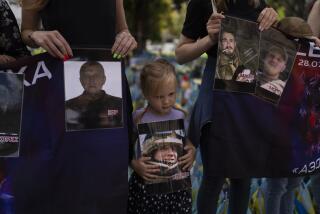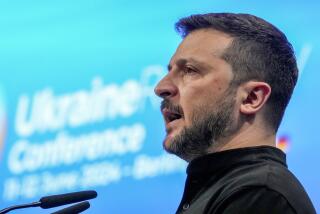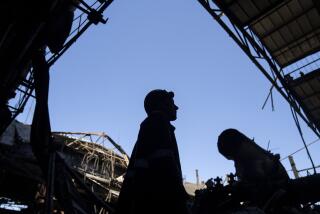Soviets Seek Advice on A-Plant Fire ‘Disaster’ : Bonn, Stockholm Help Sought, but Moscow Says Only 2 Died
MOSCOW — The Soviet Union on Tuesday asked the West German and Swedish governments for advice on fighting the fire at its nuclear plant in the Ukraine and officially labeled the accident a “disaster.”
In its first acknowledgment of casualties from any nuclear accident, the Soviet government announced that two people were killed during the accident at Chernobyl and indicated that thousands of others were evacuated from the surrounding area.
Major Soviet newspapers Tuesday carried no stories and no pictures about events at Chernobyl, but Radio Moscow described what happened as a “disaster.”
The accident is believed to have occurred last Saturday. The Soviet government said the “radiation situation” around the Chernobyl plant, about 60 miles north of Kiev, had “stabilized” Tuesday but was being constantly monitored.
In Washington, Kenneth L. Adelman, director of the Arms Control and Disarmament Agency, told a congressional hearing that at least 2,000 people lived in a village near the reactor and that Soviet reports of only two deaths “seem preposterous . . . in terms of an accident of this magnitude.”
Adelman described the site as “a lethal area” and said the reactor temperature was believed to be 4,000 degrees Centigrade.
In addition, United Press International quoted an unnamed resident of Kiev with close contacts with hospital and rescue officials as saying by telephone: “Eighty people died immediately, and some 2,000 people died on the way to hospitals. The whole October Hospital in Kiev is packed with people who suffer from radiation sickness.”
However, Kiev is now off-limits to the Western press, and there was no independent confirmation of this report. Some foreigners living in Kiev said that life in the city of 2.4 million appeared normal.
According to Reagan Administration sources in Washington, the accident involved a sizable explosion, apparently followed by a meltdown in the reactor. The site is possibly still emitting radioactive gases, the sources said.
West German and Swedish nuclear scientists indicated that on the basis of the Soviet request for help, they regarded the fire as still continuing--and possibly out of control--at Chernobyl.
Called the Worst
An official at West Germany’s Research Ministry said it appeared “almost certain” that the Chernobyl accident was the worst in the history of the peaceful use of nuclear power.
And another German expert said Soviet citizens who were badly contaminated by the accident could die after a three- or four-day period.
A spokesman for West Germany’s Atomic Forum, an institute operated by the country’s atomic energy industry, said an official from the Soviet Embassy showed up Tuesday urgently seeking advice on how to deal with a graphite fire. Graphite is a key substance in the Chernobyl plant.
According to the West German, the information he was given indicated that the fire in the Chernobyl reactor was out of control. This, authorities said, could release huge amounts of radiation.
The spokesman said that the institute was assembling data on qualified Germans who could fight a reactor fire but that it was not clear whether the Soviets wanted experts on hand or merely advice.
In Stockholm, officials at the government’s Nuclear Inspection Authority said the Soviet Union had asked their advice on the same subject.
The British gained experience fighting a somewhat similar graphite fire at the Windscale Pile plutonium-producing reactor, near Liverpool, in a 1957 accident. They extinguished it after six days by injecting massive amounts of water to cool the reactor.
The Windscale fire was one of the world’s most serious nuclear accidents, and though it caused no immediate deaths or injuries, authorities ordered the dumping or destruction of large amounts of milk and livestock in the area around the plant on the Irish Sea coast in northwestern England.
According to the official Soviet statement, the accident destroyed part of the structure of the building housing the reactor, and there was “a certain leak of radioactive substances.”
“The necessary medical aid is being given to those affected,” the statement added.
The government made no mention of the number of people seriously endangered by radiation, but unofficial estimates were that at least 10,000 people lived near enough to the plant to be evacuated as a precautionary move.
The Associated Press reported that two American tour groups, including about 25 Long Island, N.Y., high school students, were in Kiev as news of the disaster unfolded, but quoted tour organizers as saying that everyone is safe.
Both groups left April 23 for Moscow and are scheduled to return to New York on Sunday, according to a spokesman for Finnair, the airline that organized the tours.
3 Other Reactors
Beyond the affected reactor, three other reactors in the Chernobyl complex were shut down without any damage, according to the announcement read on the main evening television news.
According to the newscast, Boris Y. Shcherbina, a deputy premier and former head of construction for the oil and gas industry, was heading a commission of scientists to investigate the accident.
The tone of the announcement fit with the Soviet Union’s repeated reassurances to its people that nuclear power generation is as safe as other methods of producing electricity, if not safer.
Tight Blackout
Otherwise, however, the Soviet government imposed a tight blackout on information about the accident.
Izvestia, the official government newspaper, was the only national daily to carry even the government’s four-sentence admission on Monday that an accident had occurred.
Journalists were told that they would not receive permission to travel to Kiev to seek first-hand information on the disaster.
Diplomats from several European countries who requested more details about the accident came away from the Foreign Ministry empty-handed.
West German technicians working in Kiev, however, reported to their embassy in Moscow that they were told that a 20-mile security zone had been established around the plant.
As usual, when disasters occur within the Soviet Union, the government is inclined to say little or nothing. Only the appearance of radioactive clouds over Scandinavia on Monday may have forced the Soviets to acknowledge that a major accident had occurred, despite earlier denials.
New Town Evacuated
By reading between the lines of the official announcement, however, it appeared that about 10,000 people were evacuated from Pripyat, the new town created for workers at the Chernobyl plant, and from three nearby population centers.
Although West Germany and Sweden disclosed that the Soviet Union has asked for aid in snuffing out the reactor fire, the announcement by the Council of Ministers--which functions as the Soviet Cabinet--made no mention of a fire or any request for outside assistance.
Meanwhile, the Swedish radiological institute said it would be unsafe to go within 60 miles of the Chernobyl reactor because of the high levels of radiation that were likely to be present.
The Soviet announcement, however, gave no such warning.
“The radiation situation at the electric power station and the adjacent territory has now been stabilized, and the necessary medical aid is being given to those affected,” said the statement carried by the official news agency Tass.
Continuous Monitoring
“The state of the radiation situation . . . is being monitored continuously,” the statement added.
The Soviet requests for aid came as several countries in Northern Europe criticized the Moscow leadership for not notifying them about the dangers of fallout from the radioactive cloud that have been moving northwesterly from the site of the nuclear failure.
The cloud has crossed the Soviet border and passed over Finland, Sweden and parts of Poland, Denmark and Norway, sources said.
A Swedish sampling of increased radiation in the atmosphere Sunday was the first news in the West that a nuclear calamity had taken place in the Soviet Union.
The Swedes and the Germans were privately furious that the Soviets would ask their advice on controlling a nuclear core fire while providing such a dearth of information as to what was happening at Chernobyl.
Danish Criticism
In Copenhagen, Danish Prime Minister Poul Schlueter declared, “The government takes the view that it is quite unacceptable that the Soviet Union did not unhesitatingly inform other countries about the accident.”
Some Danish pharmacies reported a run on potassium iodide tablets, which are thought to counter some effects of radiation.
In Bonn, Interior Minister Friedrich Zimmermann offered the Kremlin all the technical help available in the country but also said the delay by Moscow in reporting the radiation leak was “unacceptable” and called for special monitoring of the atmosphere across Germany.
And Technology Minister Heinz Riesenhuber said the Soviet Union must now open all nuclear plants to international inspection to satisfy other countries that the accident was not the result of laxity or incompetence.
In Britain on Tuesday, Prime Minister Margaret Thatcher told Parliament, “We are not in a position to make a full assessment, but there have been no increases in radioactivity in this country that we have been able to detect.”
Although details of the accident remained sketchy Tuesday, there was no shortage of conjecture from West European experts as to what might have happened.
Chain Reaction Seen
Scientists at the Swedish Radiological Institute said the core of the reactor probably started burning after a chain reaction occurred between the atomic fuel and the block of graphite that is intended to moderate the flow of neutrons inside the reactor.
“If heat escalates to a high level, neutrons in the atomic process could affect carbon atoms in the graphite so that the reactor core begins burning,” one Swedish specialist at the institute said.
One of West Germany’s leading nuclear experts, Prof. Jens Scheer of Bremen University, said the reports indicated that a small explosion had occurred in a reactor, setting the graphite afire.
Prof. Adolf Birkhofer of the German Society for Reactor Safety said: “This breakdown was technically uncontrollable. I assume that the population in the reactor’s vicinity was evacuated in time. With this type of reactor, there is direct danger within six miles.”
He pointed out that Soviet reactors of the earlier Chernobyl type did not have the protection of a steel sheathing common to reactors used in the West. For that reason, Birkhofer said, the Soviet accident appears much worse than the one that occurred at Three Mile Island near Harrisburg, Pa., in 1979. In that accident, a steel casing contained most of the radiation leaking from the reactor core.
In London, exiled Soviet scientist Zhores Medvedev on Tuesday echoed the opinion that the spread of radiation apparently was enhanced by the lack of an outer protective covering for the reactor.
Medvedev is a geneticist who has published a work about a previous Soviet nuclear disaster in 1957--in which hundreds reportedly were killed in the area around Chelyabinsk in the Ural Mountains--and who now works at Britain’s National Institute for Medical Research. He said it would be hard to estimate the number of casualties from the latest disaster because the effects of radiation might not be known for four to five weeks.
In Sweden, reports of the radioactive cloud indicated that cesium 137 and other substances were detected in the atmosphere, indicating that the core of a nuclear reactor had blown up.
The reactor, a unique Soviet design modeled on the earliest atomic “piles” developed during and immediately after World War II for producing weapons-grade plutonium, has no core of fuel as such. Instead, uranium fuel rods are dispersed through a massive pile of graphite blocks, a form of carbon that slows down neutrons emitted by the fuel and allows them to interact with other uranium atoms, sustaining a chain reaction.
Hundreds of metal tubes threaded through the graphite pile carry away heat to make steam that drives turbine generators.
Several Subcompartments
A U.S. Nuclear Regulatory Commission team that visited the prototype of the Chernobyl reactor near Leningrad in 1978 reported that it had no concrete containment dome of the kind that encloses most nuclear power plants in the west. Instead, the reactor was divided into several “subcompartments” designed to withstand 4 to 5 times normal atmospheric pressure in the event of an accident, the NRC team’s report said.
The Ukraine, often referred to as the breadbasket of the Soviet Union, is mainly a vast plain with no natural boundaries except the Carpathian Mountains to the southwest and the Black Sea to the south. At 233,090 square miles, the region is slightly larger than France.
The second most populous of the 15 Soviet republics, the Ukraine has 50.8 million residents and produces over 20% of the nation’s agricultural produce. About 25% of Soviet meat and dairy products come from the Ukraine.
William J. Eaton reported from Moscow and William Tuohy from Bonn. Also contributing was Robert Gillette in Warsaw.
More to Read
Sign up for Essential California
The most important California stories and recommendations in your inbox every morning.
You may occasionally receive promotional content from the Los Angeles Times.










